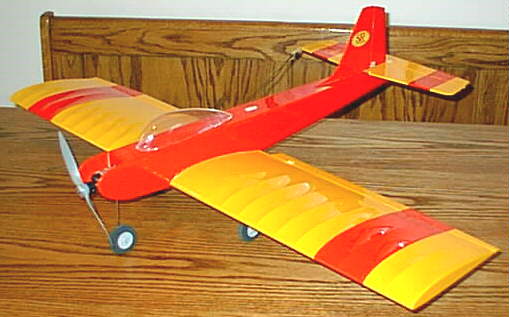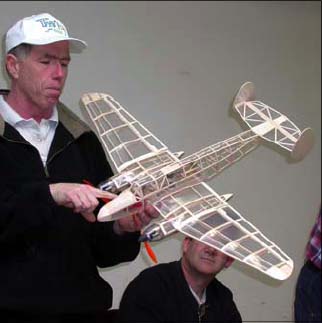 |
Flying High With Electric Power!
The Ampeer ON-LINE!
Fly the Future - Fly Electric! |
Site Table of Contents
| President: | Vice-President: | Secretary/Treasurer: |
| Ken Myers | Richard Utkan | Rick Sawicki |
| 769 Akehurst Ln | 240 Cabinet | 5089 Ledgewood Ct. W. |
| White Lake, MI 48386 | Milford, MI 48381 | Commerce Twp., MI 48382 |
| (248) 698-4668 | (248) 685-1705 | 248.685.7056 |
 | ||
| Board of Directors: | Board of Directors: | Ampeer Editor |
| David Stacer | Jack Lemon | Ken Myers |
| 16575 Brookland Blvd. | 8908 Sandy Ridge Dr. | 769 Akehurst La. |
| Northville, MI 48167 | White Lake, MI 48386 | White Lake, MI 48386 |
| 248.924.2324 | 248.698.4683 | 248.698.4668 |
| Mailed Ampeer subscriptions are $10 a year US & Canada and $17 a year world wide. FREE on-line! | ||
| The Next Meeting: Date: Monday, January 3 Time: 7:30 p.m. Place 769 Akehurst, White Lake, MI | ||
|
Brushless Motor Designations Received the following questions from Merle Davies via email: Hi Ken, Advertisements for AXI Motors describe the models i.e. "4120/14 External Rotor" Motor (MORE power than a "Gas Glow 40"). What do these Identification terms mean to the Electric Modeler? 4120/14 means the stator is 41mm by 20mm with 14 turns. External rotor means the can rotates, commonly called an outrunner. More power than a "gas glow 40". Advertising hype. KM A like explanation of the AVEOX Motor Model Designations would also be helpful. The following is the example given on the Aveox site. KM "Designation; 1409/2Y means 1.4" diameter. 0.9" magnet length, 2 turn in the Y (Wye) wind configuration." What do these terms mean to the Electric Modeler? They give a hint to the physical size of the motor and a little hint as to the Kv (RPM/volt). The 14-turn will have a lower Kv than the 2-turn. Is any of this information in the motor nomenclature really useful? Not to me. KM "Motor Kv Question
Ken, Thank you for another newsletter. I am a bit confused about Kv ratings for motors; I think it means rpm per volt of input. How does this relate to motor size and power? Is a higher rating better, more efficient use of power etc? I just got used to 300, 400, size motors and what to expect. I have an MPJ 400 size, a Razor 350 and two .020 Astro brushless motors and am familiar with what they will fly. Please explain in English, as my math is limited, or refer me to an article that I can peruse if you can.
Regards,
What you already know is what you need to know. You know that a certain motor/battery/prop combination will fly a given aircraft in a certain manner. That is what you need to know, and you are on the right track.
AXI 2820/10 Kv 1100, Rm 0.042, Io 2.5 Weight: 5.7 oz. Cermark CEM 600BL3 Kv 1100, Rm 0.09, Io 2.58 Weight 8.47 oz. (Tom Hunt review) Both motors compared at 10 volts in and assuming the same controller with the controller losses ignored for this comparison. AXI Istall = 10/.042 = 238 amps Cermark Istall = 10/.09 = 111 amps AXI amps at max eff = SQRT (2.5*238) = 24.4 amps
Cermark amps at max eff = SQRT (2.58*111) = 16.9 amps
Reported real world results:
Hunt Cermark
I hope you see from this example that the Rm and Io both play an extremely important part in the overall motor performance.
Charging Parallel Li-Po Battery Packs
The following is an answer to a question that I had forwarded to Doug, software designer of the AF109 charger, for an expert answer regarding charging parallel Li-Po packs. The original question is reprinted before Doug's answer. KM I have a query regarding charging Li-poly batteries, which I hope you can answer for me.
Thanks,
(Doug's Reply) If the packs have the same number of cells in series and are at the same state of charge (full or empty) you can charge them in parallel. If I were doing this project (the one this reply is about) I would parallel the packs and just leave them paralleled all the time. This would give you a 3S4P pack with a capacity of 8.4AH. The Astro 109 should be able to charge this in less than 2 hours. Before you parallel them you will want to charge them all separately to get them to the same state of charge (full). Doug Ingraham
A Couple of Interesting Suppliers
Ken, Thank you very much for your past support in the Ampeer!
Have a look and let me know what you think and/or what I'm missing! Regards,
Do yourself a favor and visit Ross's site to see what he has from Bondhus, Moody, Olfa, Wiha and other suppliers. Make your modeling life easier. KM And another interesting one from jen@priva.com After some late night surfing I happened upon your page about r/c flying. I saw you had an extensive amount of aviation related images and information and figured I would suggest my site to you as a possible addition. It offers collectible model aircraft, as well as military tanks, vehicles and artillery that are historically authentic and highly detailed.
Sincerely,
Powering a Pair of RC Seaplanes
A friend of mine from the Midwest RC Society asked about using electric power in a couple of seaplanes he plans to build. I thought this would be a good time to go over how I choose an electric power system. KM Ken: The following is the information regarding the two aircraft I would like to make into electric. The Republic "Seabee" wingspan is 52" in length by 6.5" in cord depth. The wing is completely rectangular in shape. This gave me 338 sq.in. 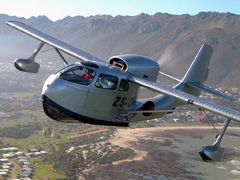
Photo of Full Scale The "Lake Buccaneer" wing is 58.5" in length by a wing cord of 8.5" at root to 5.75" at wing tip. I took a general cord depth of 8" which gave me 468 sq.in. (could be closer to 417. I'll use 420. KM) 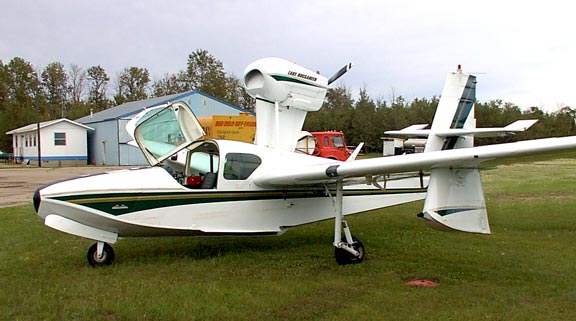
Photo of Full Scale However I will leave the real figures up to you and look forward to your answer as to what electric power and stuff I'll need.
Les Harding I received the following from Les when I asked him about prop size. Both aircraft are powered by .23 to .25 2-stroke engines. Both have pusher props and show 8x6 props. They do not leave much room for your fingers. Could use a three blade on them if this would give more power. Weight wise, the Seabee, bare, no motor, batteries, and other stuff, about10-12 oz. The Buccaneer would weigh about12-14 oz. If needed, I could build lighter. My reply:
Buccaneer (420/144)1.5 = 4.98 * 3.5 = 17.4 oz. ideal
Recommended onboard radio system (both planes):
Recommended power systems using an 8x6 prop.
Heaviest weight for the Seabee:
Heaviest weight for the Buccaneer:
The above weights try to represent "worse case" weights. The "Other weight" is an estimate and includes such things as props, pushrods, switch harnesses, wire and other weight that seems to creep into any project, and may be less or a little more, but I use about 10% of the component weights to form this guesstimate. The Kokam 3S1P 15C pack 6.1 oz and $83.50 could be the battery used with either of these power systems. The Seabee would then weigh about 36.1 oz. and the Buccaneer 42.6 oz. For the weight savings and price, I'd say go for the Li-Po's if you don't already have a charger that could charge at least 10 NiCad or NiMH batteries, and you would have to get a new charger for Li-Po charging. I highly recommend the AF-109 as the Li-Po charger. If you want to save the expense of a new charger, if you have one that can charge at least 10 cells, then the recommended batteries and heavier weights should be just fine. Monsoon RC Ken, I just received an email from Monsoon RC (www.monsoonrc.com) and thought they had some interesting items to offer.
"The Monsoon from MonsoonRC, is in a class all its own as a cross between a Pattern and a 3D plane. This plane will perform most of the acrobatic tricks that a 3D plane will but since it is made from EPP foam, it will be much more durable. As a pattern plane it will hold whatever line you put it on until you decide it is time to change directions. The Monsoon has a stabilator instead of the normal horizontal stab and elevator for better response on the pitch axis. If you cannot decide between a pattern plane or a 3D plane this is the one to get. The Monsoon is designed with the intermediate to advanced pilot in mind with the intent of pushing its flight envelope." 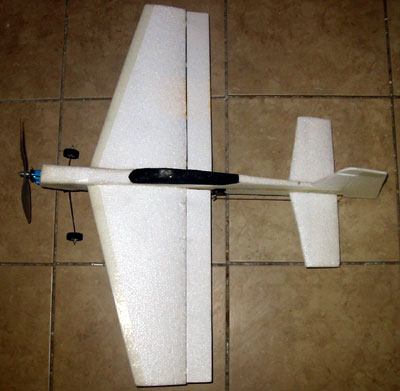 The plane may change from the photo since this is a prototype. The Monsoon comes with:
Specs:
Required:
Assembly Materials:
The Monsoon is $59.95 Plus Shipping Upcoming Las Vegas Soaring Club SuperFly IV
The Las Vegas Soaring Club SuperFly IV will take place beginning on November 12, 2005 and ending November 13, 2005. Start time will be 9:00 am. Located at Bennett Field in Las Vegas, Nevada.
This is the fourth annual ALL ELECTRIC FUN FLY. This is the first time it will be a two-day event and is growing bigger and better each year.
Charlevoix Area BUFFS New Year's Day Fly-in
Hi Ken, Just to let you and others know if they are planning on coming to Northern Michigan for the holiday, that the Charlevoix Area BUFFS are having their 26th annual New Year's Day Fun Fly. All are welcome. Bring some planes and help provide some moral support to those of us who fly with electrons.
Thanks,
Comments and Compliments on Keith's Bugatti Keith did a great job on his Bugatti and its write up here in the Ampeer. Many, many folks sent compliments on his achievement. Here are some to share with you all and to tell Keith "Well done!" From Rod Woolley rwoolley@sympatico.ca I have just finished reading the latest Ampeer at http://members.aol.com/kmyersefo
Rod in Ottawa (Where the weather stays fine enough to fly all year round!) From David Hipperson ritzi@corplink.com.au Loved this issue and the extensive report on the Bugatti racer by Keith Shaw. Way beyond my capabilities, but a thrill to read about the project. Thanks again. David and Jan Hipperson,
From Wurpfel wurpfel@yahoo.de I'm also a BUGATTI R100 fanatic...
The aerodynamic layout looked for me very tricky so I made a lil' BUGATTI out of depron and balsa as proof of concept.. and btw it fits in the top-case of my motorcycle.
Please check out my homepage, mypage.bluewin.ch/a-z/wurpfel/ for some pictures and videos. Encouraged from the success, I'm now building a 1/6 scale one. I will use two LRK 430/30 BL-engines with nearly one KW each and a laminar-flow-profile.
cu
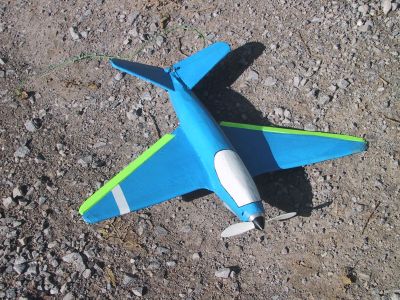
Photo from Wurpfel's Web site The story in the Ampeer about Keith's Bugatti rocked! Best regards,
Watch for the good word on the Push-E-Cat kit, one of my favorite trainers, hopefully by next month. KM Upcoming January EFO Meeting The first EFO meeting of 2005 will be held on Monday, January 3. No, the meeting date will not be changed from the usual 1st Thursday of the month, except for this meeting. The meeting will start at 7:30 p.m. at 769 Akehurst, which is located in the North Broadmoor subdivision on the east side of Union Lake Rd, about a mile north of the village of Union Lake. Akehurst is the entry road for the subdivision. There are two entrances to the North Broadmoor subdivision. Akehurst is the south entrance road. For those coming from the south traveling on Union Lake Rd., it will be the first North Broadmoor entrance that you see. If you are coming down from Elizabeth Lake Rd. from the north end, it will be the second North Broadmoor entrance. It is the fourth house in on the south side of Akehurst. There is a Real Estate One sign in the front yard. The house just west of it is also For Sale by the builder of the subdivision. You can park in that house’s driveway, if you like.
Received the following from Steve Elwell, EFO member, so thought this would be a good place to share it. Are you flying any new planes? With so many cheaper and lighter planes, motors and batteries finding their way into the marketplace I would hope that you've been acquiring some new toys. :)
I have been flying an Edge 540 Shock Flyer, with Python 60 (from Hobby Lobby) and it is a blast to fly. I never thought that 7 ounces of plane could yield so much fun. Actually with a 730x2 TP pack it is about 7. 2oz and with a 340x3 pack it is about 6.8 oz. It flies very nicely in the dome. (As we saw at the Dec. EFO meeting. KM) I am going to try to build of few of my own variants of the Shock Flyer and power them with the (17g) Feigao brushless motor and GWS D gearbox. If I can keep the weight down the Feigao might work out well for a small 3D plane. I think I saw one powering a Shock Flyer at the dome the last time I was there. I would love to plug one of those into my 4.5 oz Mini Speed Wing. Hopefully I'll get around to that soon. So many ideas, but never enough time to get around to them all. Winter might provide a bit more indoor workshop-time!
The need for speed has also managed to allow me to damage a Kokam 3x2000 pack, while pushing my Mega 3T powered ProJeti harder than I should. With the small props (~4.75x4.75) it doesn't unload much in the air, so what you see/read [on the ground] with your wattmeter is close to what you get [in the air]. This ProJeti is sure a lot of fun - a bit over 100mph. I decided to get a little crazy on Sunday (At Ray Field in New Hudson) and try the ProJeti with 12xCP1300 Ni-Cd and a 5.5x7.5 prop (~ 425W, @50A). It seemed to move a little quicker, but not for long on the smaller cells with higher current draw. Launching it was also a bit of an adventure. With the 5.5" diameter prop I decided that full throttle launching could risk the fingers, so I had someone toss it (really hard) with power off. The trick with this setup and power-off launch is that the startup torque can roll the plane into the ground. Additionally, the added weight of the 12xCP1300 pack (15oz vs. 6oz for the 2000x3 LiPo) yields launch performance similar to that of a red brick - an expensive red brick! :) I managed to stay on the throttle, and with full-high-rate up-elevator, I saved it about 10" off the ground - I got an applause for that one! :) Then I was in for a fun-filled 3-minute flight - that "long" duration only because I managed the throttle most of the time. I may not be trying that combination again.
Take care,
Thanks for the update and tips Steve. It is always good to know what the EFO members are up to.
My SR Batteries X250
Back in 2000 I built the SR Batteries (www.srbatteries.com) X250. The construction and review article is still on the EFO site. It has been my "fly it every time I go to the flying field plane". I have no idea how many hours it has on it, but it is a lot!
Tom Hunt's Bugatti R100
Tom Hunt's "Work In Progress" model is the "Bugatti R100". This model, under construction with a 144 sq. in. wing that has a 30" span. The smooth lines of this scale aircraft are a good example of how Tom designs and builds these models. It was not ready for the trip to Toledo, but Tom wanted us to see how it was progressing. It will use a GWS IPS V drive and a 7 x 6 prop. Weight to be 8 oz. More to come on this beautiful airplane when he finishes it. 
|
To Reach Ken Myers, you can land mail to the address at the top of the page. My E-mail
address is:
KMyersEFO@aol.com
EFO WEBsite: http://members.aol.com/KMyersEFO/
